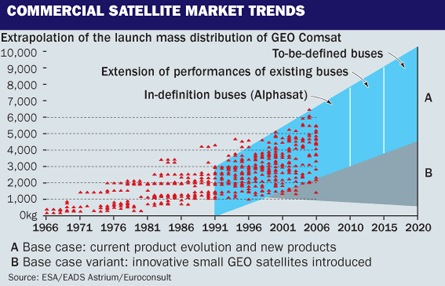Telecommunications spacecraft are set to get bigger to service high definition television and fixed and mobile internet services, including for airborne users.
This ongoing telecoms revolution is ensuring that these spacecraft are the commercial engines of the satellite market, but they are substantial in more than just economic terms. To accommodate current and expected demand for services, these satellites are getting heavier, a trend that raises questions about Europe's ability to launch them.
Critically, telecoms satellites operate in geostationary orbits (GEO), about 36,000km (22,300 miles) high. These are the most challenging altitude for launchers; by comparison, the International Space Station sits in a low low Earth orbit at about 400km.
According to the European Space Agency's Tomorrow's Bird study - bird being a term used for spacecraft - by the end of this decade telecoms satellites could have masses of 10,000kg (22,000lb), as operators seek to mitigate against high launch costs by building spacecraft able to handle growing demand for services (see table below). But today the heaviest spacecraft making the journey to GEO are up to 7,000kg. To reach GEO the spacecraft are injected into a lower "geostationary transfer orbit," or GTO, and then propel themselves to their higher destination.
 |
|---|
© Flightglobal/Tim Bicheno-Brown |
Tomorrow's Bird foresees promising miniaturisation breakthroughs being made in fuel cells, refuelling and, eventually, in-orbit servicing. By 2020, likely improvements may include better lithium ion batteries, electric propulsion and perhaps surprisingly, inflatable structures. But these technologies are equally applicable to the larger satellites that are expected to dominate the market anyway.
European Space Policy Institute resident fellow and commercial satellite expert Matxalen Sánchez Aranzamendi says: "The reason [for larger spacecraft] seems not to be so much based on technical advantages...but rather on the costs involved per launch. Therefore powerful satellites with the capacity to absorb the demands of future telecoms services [are] preferable."
Through its Future Launcher Preparatory Programme (FLPP), ESA is designing a rocket that by 2025 will replace its Ariane 5, which is now operated commercially by Arianespace from the French space agency CNES' Guiana Space Centre in French Guiana. The challenge for an Ariane 5 replacement is to be able to launch those large satellites and reduce the cost of launching small spacecraft.
At his 14 January press conference ESA director general Jean Jacques Dordain gave an insight into the new expendable launcher's design, saying it would be "modular". An FLPP concept has been an expendable two-stage booster using liquid hydrogen for both boosters, and two to six strap-on solid rocket boosters attached to increase its GTO payload capability from 3,000kg to 8,000kg.
The idea of a modular rocket to perform many missions is included in the Tomorrow's Bird study. Its design has a modular concept that uses additional stages and solid rocket boosters to directly inject clusters of small spacecraft into their orbit (see graphic). A basic version lofts single large satellites into GTO.
But the mystery at the heart of European rocket development is that this FLPP booster has a maximum GTO payload of 8,000kg - short of the 10,000kg expected to be demanded in 2020. ESA's Alphabus programme will result in a satellite, the first of which is to launch in 2012, that has the growth potential to reach 9,000kg from its baseline 6,000kg mass.
 |
|---|
© Flightglobal/Tim Bicheno-Brown |
The move to develop a single rocket capable of different missions is also perplexing for launcher experts. US National Air and Space Museum curator Roger Launius says: "The single rocket idea has never worked very well."
And ESA's launcher policy until now has been to create a family of launchers. It is still in the process of preparing to operate from French Guiana from 2011 the Ariane 5 for heavy spacecraft, the Italian-led Vega for small spacecraft and Russia's medium-class Soyuz.
Launius speculates that the 1,000kg gap mystery may be traced to unstated defence requirements - Dordain mentioned co-operation with the European Defence Agency at his press conference.
Tomorrow's Bird was to have been a two-year study finished by early 2008, but two years on ESA has released only executive summaries. Its implications for Europe's rockets mean, in retrospect, the study should probably have been called Tomorrow's Launcher.
Source: Flight International



















